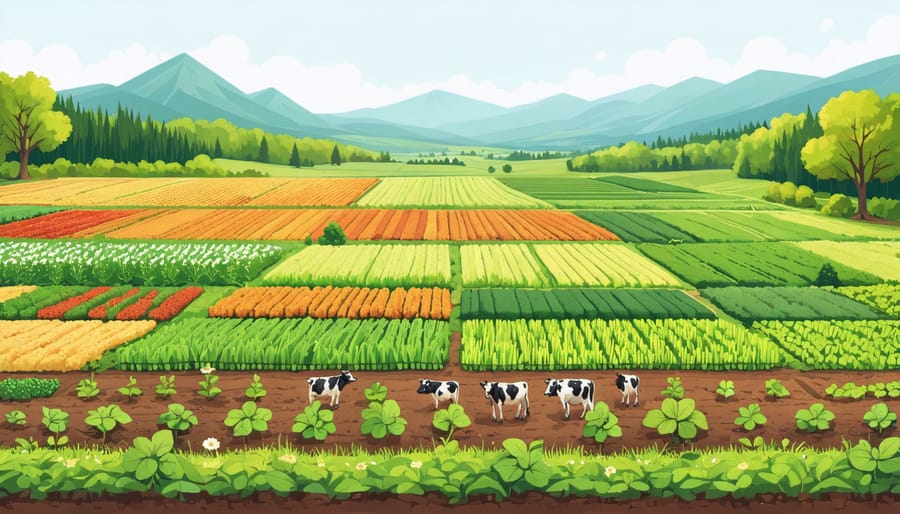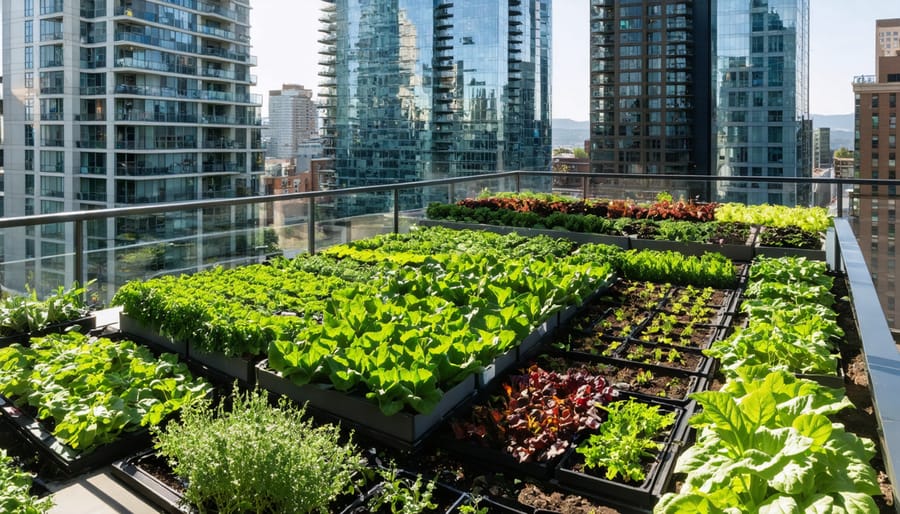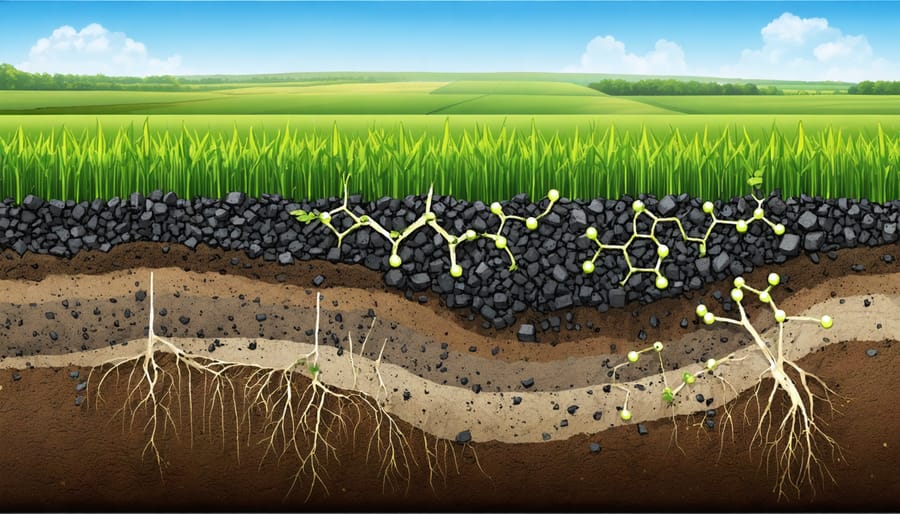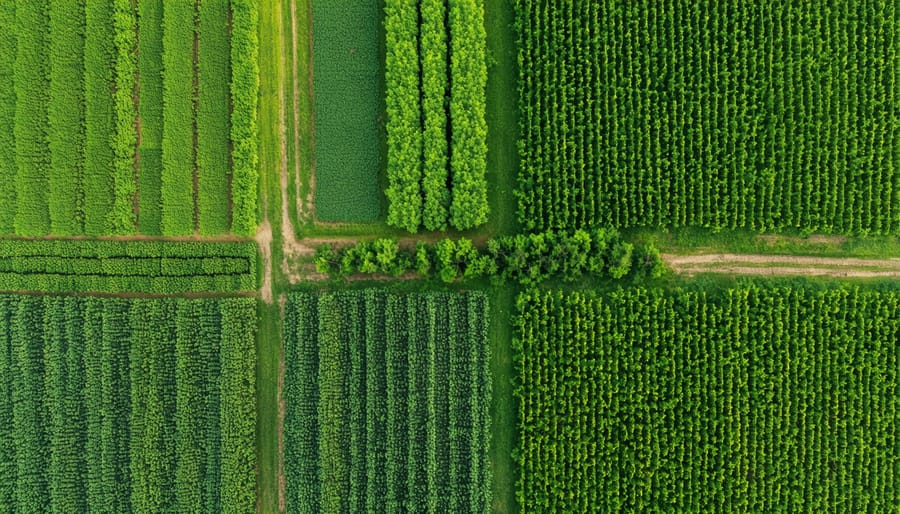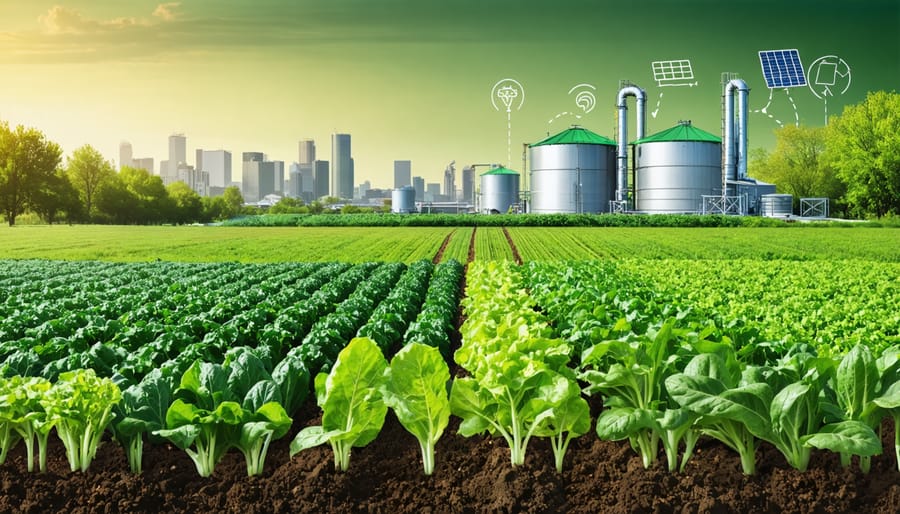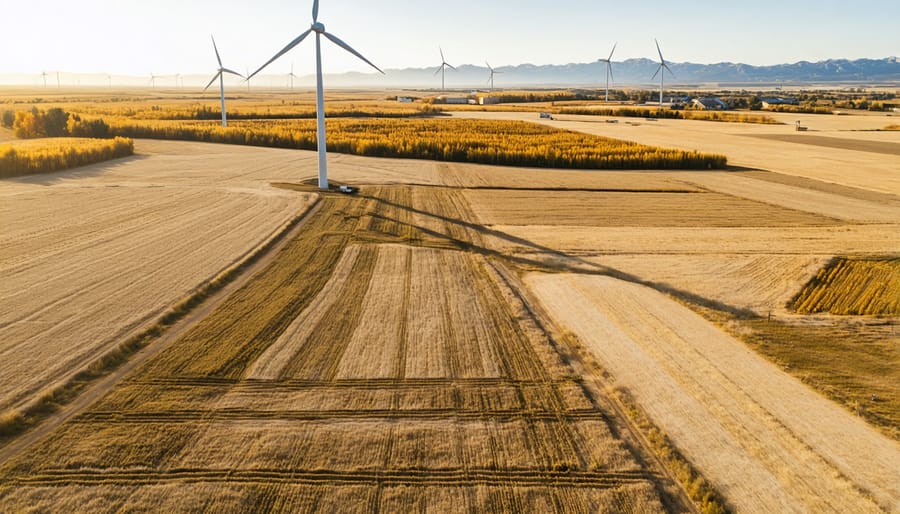Transform farmland into powerful carbon sinks through proven natural climate solutions that boost both soil health and crop yields. Prairie farmers practicing organic farming in Alberta already sequester 25-35% more carbon annually compared to conventional methods. Plant diverse cover crop mixtures including deep-rooted species like alfalfa and clover to pull carbon deeper into soil profiles while fixing nitrogen naturally. Establish shelterbelts using native trees and shrubs to create windbreaks that prevent soil erosion, protect crops, and store additional carbon above and below ground. Integrate rotational grazing with crop production to build organic matter through manure deposits while maintaining permanent ground cover. These field-tested approaches have helped Alberta producers cut input costs by an average of 30% while building climate resilience through improved water retention and reduced erosion risk.
Carbon-Rich Soil: Nature’s Climate Shield
Building Living Soil Systems
Building healthy soil systems is fundamental to both farm productivity and soil carbon sequestration. Here in Alberta, successful farmers are implementing a variety of organic practices that enhance soil organic matter and support thriving microbial communities.
Cover cropping has proven particularly effective in our prairie conditions, with farmers reporting significant improvements using combinations of clover, vetch, and rye. These plants protect the soil surface while their roots create valuable organic matter below ground. Local producer Sarah Thompson from Red Deer County observed a 2% increase in soil organic matter over five years using this approach.
Crop rotation is equally crucial, ideally incorporating four or more crops in sequence. Including nitrogen-fixing legumes, deep-rooted perennials, and diverse annual crops helps build soil structure while managing pest and disease pressures naturally. Composting and applying organic amendments, such as well-aged manure or locally sourced compost, further enhances soil biology.
Minimal tillage practices, when combined with these methods, help preserve soil structure and protect beneficial organisms. Many Alberta farmers are successfully using roller-crimpers and other innovative tools to terminate cover crops while maintaining soil integrity. These integrated approaches not only improve soil health but also increase water retention capacity, particularly valuable in our semi-arid climate.
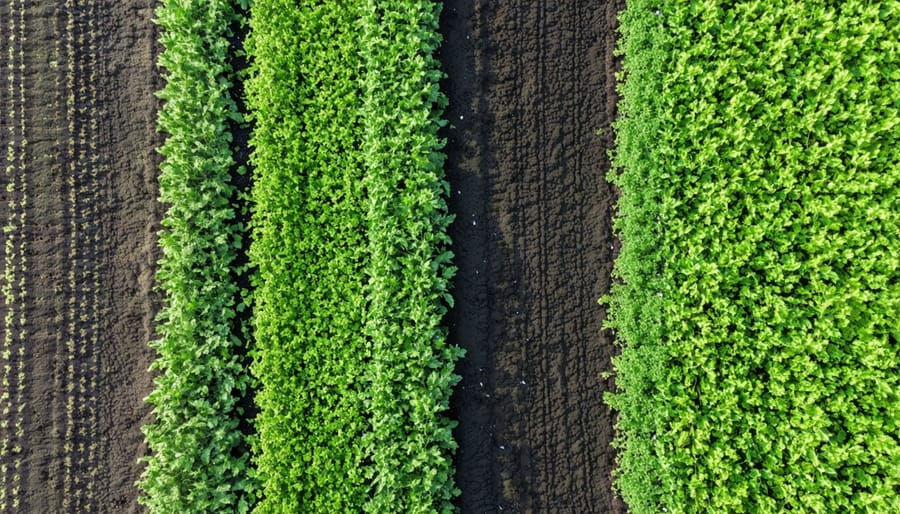
Cover Cropping Success Stories
Jason and Sarah Miller, third-generation farmers near Lacombe, Alberta, transformed their 800-hectare operation by incorporating cover crops into their rotation five years ago. “We started small with just 40 hectares of clover after our barley harvest,” Jason explains. “The soil improvement was so dramatic that we’ve expanded every year since.”
The Millers now use a diverse mix of cover crops, including fall rye, hairy vetch, and field peas, reporting a 15% increase in soil organic matter and an estimated carbon sequestration of 2.5 tonnes per hectare annually. Their success has inspired neighboring farms to adopt similar practices.
In Southern Alberta, Tom Chang’s 400-hectare farm near Lethbridge demonstrates how cover cropping can thrive in drier conditions. “We’ve adapted our cover crop selection to include drought-resistant species like sunflowers and buckwheat,” Chang shares. His innovative approach has led to a 20% reduction in irrigation needs while maintaining soil coverage throughout the year.
Near Grande Prairie, the Peterson family farm has successfully integrated winter camelina into their rotation, protecting their soil during harsh northern winters. “It’s not just about carbon storage,” explains Linda Peterson. “We’ve seen better water retention, fewer weeds, and healthier crops overall. The economic benefits have matched the environmental ones.”
These success stories showcase how Alberta farmers are leading the way in climate-smart agriculture while building more resilient farming operations.
Water Management That Works With Nature
Smart Irrigation Techniques
In Alberta’s semi-arid climate, implementing effective water conservation strategies is crucial for sustainable farming. Modern smart irrigation techniques combine traditional wisdom with cutting-edge technology to maximize water efficiency while maintaining crop yields.
Soil moisture sensors and weather-based irrigation controllers have proven particularly effective in the Prairie region. Local farmer Sarah Thompson from Lacombe County reported a 30% reduction in water usage after installing soil moisture monitors across her 200-hectare canola field. These sensors provide real-time data about soil conditions, allowing for precise irrigation scheduling.
Drip irrigation systems, while requiring initial investment, have shown remarkable results in Alberta’s market gardens and orchards. These systems deliver water directly to plant roots, reducing evaporation and improving water use efficiency by up to 40% compared to conventional sprinkler systems.
For broad-acre crops, low-pressure pivot irrigation systems equipped with drop nozzles have become increasingly popular. These modifications help minimize water loss through wind drift and evaporation, particularly during Alberta’s hot summer months. The Irrigation Research Foundation in Brooks has demonstrated that properly maintained pivot systems can achieve application efficiencies of 85-95%.
Variable rate irrigation technology, coupled with GPS mapping, allows farmers to adjust water application based on soil type, slope, and crop requirements within the same field. This precision approach ensures optimal water distribution while preventing over-irrigation in low-lying areas.
Wetland Integration
Wetlands are powerful allies in building farm resilience, offering natural solutions for water management and climate adaptation. In Alberta, where extreme weather events can challenge agricultural operations, preserved and restored wetlands act as natural buffers against both drought and flooding.
For example, the Miller family farm near Red Deer has integrated existing wetlands into their operation, maintaining these areas as natural water storage systems. During dry spells, these wetlands help maintain soil moisture in adjacent fields, while in wet years, they prevent field flooding by absorbing excess water. Their wetlands also filter agricultural runoff, improving water quality across their property.
Wetland integration can be as simple as preserving existing low-lying areas or as involved as restoring previously drained wetlands. Many Alberta farmers have found success with buffer zones – strips of permanent vegetation around wetland edges that prevent erosion and create wildlife habitat. These zones can be productive spaces for growing forage or native plants while protecting water resources.
The benefits extend beyond individual farms. Connected wetland systems help regulate regional water tables and provide crucial ecosystem services. Through programs like Alberta’s Wetland Conservation Offset Program, farmers can receive support for wetland preservation and restoration efforts, making this natural climate solution both environmentally and economically sound.
Consider starting small by identifying natural depressions or existing wetland areas on your land, then gradually developing management practices that work with these features rather than against them.
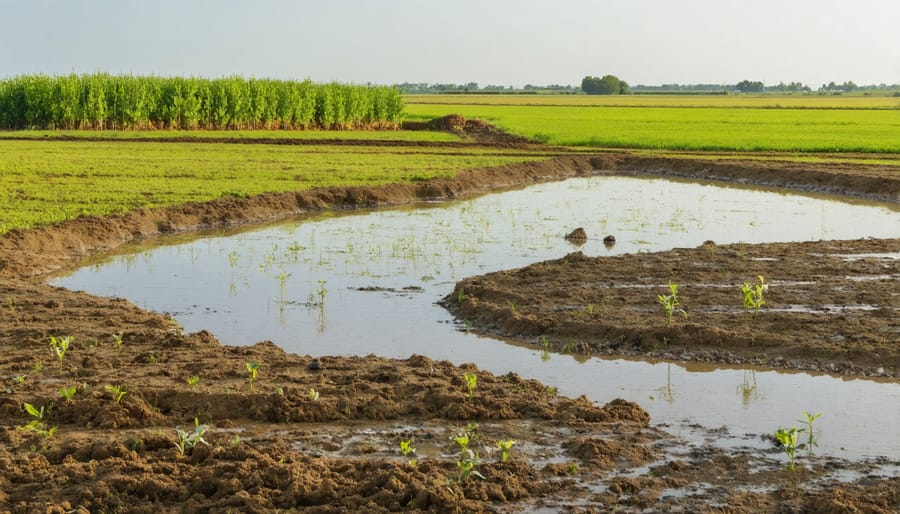
Biodiversity as a Climate Solution

Native Plantings and Beneficial Insects
Native plants and beneficial insects form a crucial partnership in creating resilient agricultural ecosystems. By incorporating indigenous plant species like yarrow, goldenrod, and prairie coneflower into field margins and hedgerows, farmers can naturally enhance their land’s biodiversity while supporting local pollinators. These native species are already adapted to Alberta’s climate conditions and require minimal maintenance once established.
Research from the University of Alberta shows that farms implementing beneficial insects in organic farming systems through native plantings see up to 60% reduction in pest-related crop damage. Strategic placement of flowering natives like wild bergamot and blanketflower creates natural corridors that attract beneficial predatory insects such as lady beetles and parasitic wasps.
Local farmer Sarah Thompson from Lacombe County shares, “Since establishing native plant borders around our fields, we’ve seen a dramatic increase in beneficial insect activity. Our need for pest management has decreased significantly.” The key is selecting a diverse mix of plants that flower at different times throughout the growing season, ensuring continuous habitat and food sources for beneficial insects.
Consider starting with hardy species like blue flax, prairie sage, and black-eyed susan, which establish quickly and provide excellent insect habitat. These plants also contribute to soil health through deep root systems and natural biomass production.
Agroforestry in Action
Several Alberta farmers are leading the way in agroforestry implementation, demonstrating how these practices can thrive in our prairie climate. The Henderson family farm near Lacombe has successfully integrated shelterbelts with their crop rotation system, reporting a 15% increase in yield on adjacent fields while sequestering an estimated 2.5 tonnes of carbon per hectare annually.
In the Peace Country region, Marie Baptiste’s operation showcases the benefits of silvopasture, where cattle graze among purposefully planted spruce and poplar trees. Her innovative approach has reduced feed costs by 20% during winter months while providing natural shelter for livestock. The trees also serve as wildlife corridors, enhancing biodiversity on her land.
Near Red Deer, the Cooper Valley Farm project demonstrates successful alley cropping, alternating rows of saskatoon berries with traditional grain crops. This system has created additional revenue streams while improving soil health through increased organic matter content.
The Agroforestry and Woodlot Extension Society of Alberta reports that farms implementing these systems have seen up to 30% reduction in wind erosion and improved water retention during dry periods. Local success stories like these are inspiring more Alberta farmers to explore agroforestry as a viable strategy for both climate resilience and farm profitability. Free consultations and support are available through various provincial programs to help farmers begin their agroforestry journey.
Measuring Success: Real Results from Alberta Farms
The results from Alberta farms implementing natural climate solutions speak volumes about their effectiveness. Take the Morrison Family Farm near Red Deer, which has seen a 35% increase in soil organic carbon levels over five years through their adoption of cover cropping and reduced tillage practices. Their success isn’t just environmental – they’ve reduced fuel costs by $45 per hectare annually.
In Lacombe County, Sarah Jensen’s 800-hectare operation demonstrates the power of rotational grazing. Since implementing this practice in 2018, she’s documented a 40% improvement in water retention and eliminated the need for synthetic fertilizers on her pastures, saving approximately $12,000 yearly while maintaining productivity.
“The change in our soil structure has been remarkable,” shares Tom Williams, who farms near Camrose. “We’ve measured a 28% increase in earthworm populations, and our fields now absorb water four times faster than they did before we started using regenerative practices.” Williams’ farm has become a local success story, showing how natural solutions can improve both climate resilience and profitability.
The Alberta Conservation Association has collected data from 25 farms implementing these practices, revealing:
– Average soil organic matter increases of 2.1% over three years
– 45% reduction in synthetic input costs
– 30% improvement in water infiltration rates
– 25% decrease in fuel consumption
– Enhanced crop resilience during extreme weather events
The Stephenson family near Medicine Hat has documented their journey transitioning to regenerative practices over seven years. Their data shows a 50% reduction in irrigation needs and a 40% increase in soil biodiversity. Most importantly, they’ve maintained crop yields while reducing operating costs by 32%.
“What’s particularly encouraging,” notes Dr. Maria Rodriguez from the University of Alberta’s Agricultural Research Center, “is that these farms are achieving these results while maintaining or improving their profitability. This isn’t just about environmental benefits – it’s about building more resilient farm businesses.”
These success stories demonstrate that natural climate solutions aren’t just theoretical – they’re delivering measurable benefits to Alberta farmers’ bottom lines while contributing to climate resilience.
Natural climate solutions offer Alberta farmers a powerful opportunity to be at the forefront of climate action while enhancing their agricultural operations. By implementing practices like cover cropping, rotational grazing, and wetland restoration, farmers across our province are already demonstrating that these solutions can work effectively within our unique landscape and climate conditions.
The benefits extend far beyond carbon sequestration. These practices improve soil health, increase water retention, enhance biodiversity, and create more resilient farming operations that can better withstand extreme weather events. Many farmers report increased yields and reduced input costs after adopting these methods, proving that environmental stewardship and profitable farming can go hand in hand.
As our agricultural community faces increasing challenges from climate change, natural climate solutions provide practical, tested approaches that can make a real difference. The success stories from local farms show that these methods are both feasible and beneficial in our Alberta context. Whether you’re managing a small family farm or a large agricultural operation, there’s a natural climate solution that can work for your land.
We encourage you to start small, perhaps with a test plot or single field, and gradually expand these practices as you see the results firsthand. Remember, you’re not alone in this journey – our local agricultural extension services, farmer networks, and conservation groups are here to provide support and guidance as you implement these solutions.

